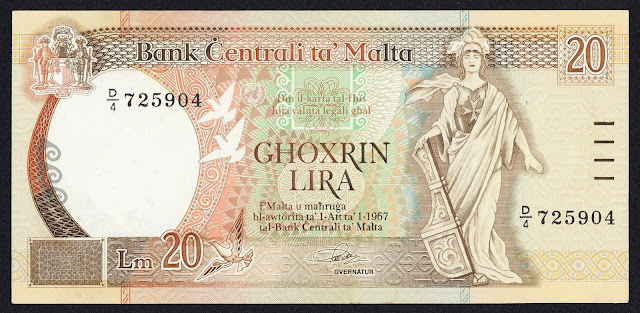Malta Banknotes 20 Maltese Lira banknote 1989
Central Bank of Malta - Bank Ċentrali ta’ Malta
Obverse: The central theme is a figure of a woman holding a rudder, symbolising Malta in control of her own destiny. Other features are three doves symbolising peace, the United Nations Emblem, the Central Bank of Malta Coat of Arms, and mosaic designs from the period of Roman presence in Malta.
Reverse: Dr Borg Olivier, Prime Minister in 1964 when Malta was granted its Independence, raising of the Maltese flag and a marble tablet in Valletta commemorating Independence on 21 September 1964, Malta Independence Act 1964 at right.
Watermark: Turreted allegory of Malta - Melita.
Format: 76mm x 145mm - Colour: Brown.
Malta banknotes - Malta paper money
The 5th series of banknotes was issued in 1989 to coincide with the 25th anniversary of Malta’s independence. The banknotes depict the Edward Caruana Dingli allegorical figure of Melita holding a rudder. This represented Malta taking control of her own destiny.Maltese banknotes were replaced by euro when Malta became a member of the euro area and adopted the euro as its currency on 1 January 2008. Subsequently, the Maltese currency remained legal tender until 31 January 2008. However Maltese banknotes can still be exchanged for euro at the Central Bank of Malta for up to ten years after being demonetised, that is, till 31 January 2018.
2 Maltese Lira 5 Maltese Lira 10 Maltese Lira 20 Maltese Lira
Giorgio Borġ Olivier
Giorgio Borg Olivier (5 July 1911 – 29 October 1980) was a Maltese statesman and leading politician. Borg Olivier was twice Prime Minister of Malta (from 1950 to 1955, and from 1962 to 1971) as the Leader of the Nationalist Party. He was also Leader of the Opposition between 1955 and 1958 and again between 1971 and 1977.
Borg Olivier was elected as one of the three Nationalist members of the Council of Government in 1939. In May 1940, when the leader of the Nationalist party, Enrico Mizzi, was first interned by the British and deported, Borg Olivier became interim leader. After his return, Mizzi made Borg Olivier his right-hand man and deputy. Rising to office as a protégé of Mizzi and Sir Ugo P. Mifsud, Borg Olivier believed in the economic and social development of Malta as a viable independent state and in the necessity of a mixed economy. During his premiership, he pursued corporatist policies to develop the tourism industry and construction as the engine of growth. Under his leadership, average living standards rose steadily as Malta began to decouple from a fortress economy purely dependent on the British military establishment.
Near the end of his rule as prime minister, his government was rocked by various political and personal scandals, which seemed to symbolise the moral decay of the Maltese political establishment. Resigning from Leader of the Nationalist Party in 1977, Borg Olivier retained his parliamentary seat until his death in 1980. He was succeeded as leader of the party by Eddie Fenech Adami.
Malta Independence Day 21 September 1964
Malta achieved its independence on 21 September 1964 (Independence Day) after intense negotiations with the United Kingdom, led by Maltese Prime Minister George Borġ Olivier. This is celebrated as Independence Day or Jum l-Indipendenza in Maltese. Under its 1964 constitution, Malta initially retained Queen Elizabeth II as Queen of Malta and thus Head of State, with a Governor-General exercising executive authority on her behalf. In 1971, the Malta Labour Party led by Dom Mintoff won the General Elections, resulting in Malta declaring itself a republic on 13 December 1974 (Republic Day) within the Commonwealth, with the President as head of state.

